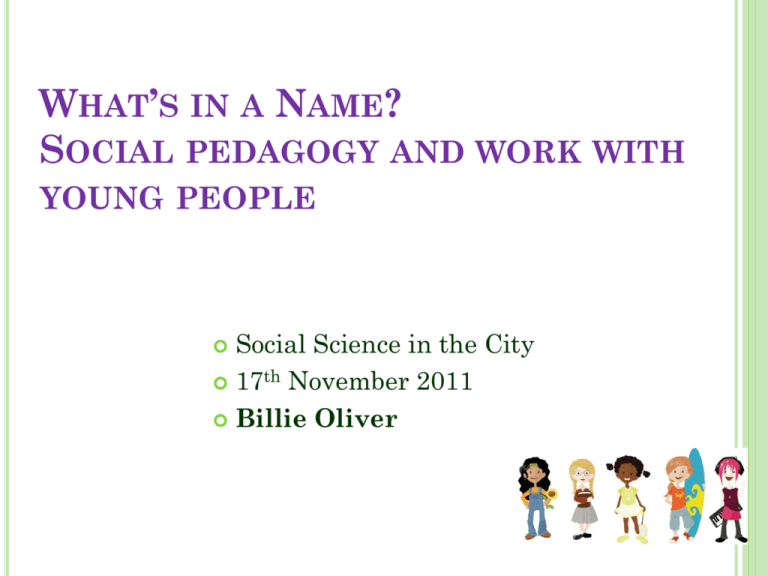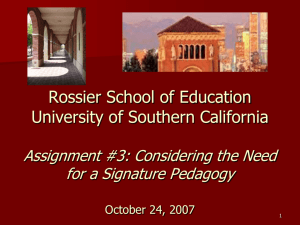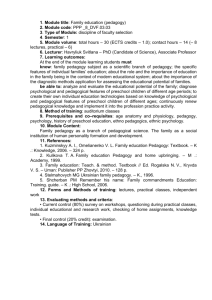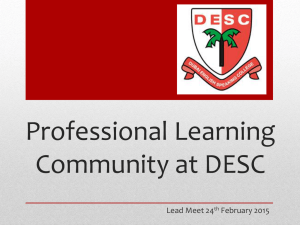What's in a Name? Social pedagogy and work with young people
advertisement

WHAT’S IN A NAME? SOCIAL PEDAGOGY AND WORK WITH YOUNG PEOPLE Social Science in the City 17th November 2011 Billie Oliver WHAT DO WE MEAN BY SOCIAL PEDAGOGY? Social pedagogy is a concept, or way of thinking, which is widely used in European countries such as Germany, Denmark and Sweden. It is a way of thinking about care and education, which does not see them as separate and acknowledges the social reality of being human There is no ‘one way’ and it is not restricted to specific client or age groups It is a ‘how’ not a ‘what’: t is a way of thinking, feeling and working with people in different contexts Uses Common Third: using a third element to build relationships and foster learning Uses Life space – the importance of the everyday WALKING IN THE SHOES OF Reflecting the ‘close and empathetic nature of the social pedagogue’s relationship with the young people they work with’. (Kathy Oxtoby, 2009) Close relationships between children or young people and professionals is a distinctive feature of European social pedagogy. Social pedagogy places great emphasis on the child or young person, and puts them at the centre of the work. A holistic perspective is very important within the social pedagogy approach and this perspective is the basis of interventions planned around the child or young person. SOCIAL PEDAGOGY IN EUROPE Qualified social pedagogues in Europe are trained so that they have a broad knowledge of all the different sectors, while still keeping their own specialisms. Social pedagogues have a broad understanding of psychology, sociology, social work, education, health and other disciplines. The breadth of pedagogic training qualifies professionals for direct work with children and young people with diverse needs across a wide range of child care and welfare services, including residential and foster care, early years and youth work. This creates a flexible workforce which enjoys the opportunity to work in different sectors at different stages of their career. THE PETRIE PRINCIPLES A focus on the child as a whole person, and support for the child’s overall development; The practitioner seeing herself/himself as a person, in relationship with the child or young person; Children and staff are seen as inhabiting the same life space, not as existing in separate hierarchical domains; As professionals, pedagogues are encouraged constantly to reflect on their practice and to apply both theoretical understandings and self-knowledge to the sometimes challenging demands with which they are confronted; Pedagogues are also practical, so their training prepares them to share in many aspects of children’s daily lives and activities; Children’s associative life is seen as an important resource: workers should foster and make use of the group; Pedagogy builds on an understanding of children’s rights that is not limited to procedural matters or legislated requirements; There is an emphasis on team work and on valuing the contribution of others in 'bringing up' children: other professionals, members of the local community and, especially, parents; The centrality of relationship and, allied to this, the importance of listening and communicating.“ CWDC (2005) A concept whereby the child is seen as being a social being, with his or her own distinctive behaviour and knowledge, and where the social pedagogue (or children and young people’s professional) works closely with the individual to enable them to develop their own potential’. WHAT DO WE MEAN BY YOUTH WORK? Smith (2002) admits that when people talk about youth work ‘they can mean very different things’ and that it might be more helpful to think of there being different forms of youth work rather a single practice with commonly agreed characteristics. WHAT IS YOUTH WORK? (MARK SMITH) Youth work involves focusing on young people, emphasising voluntary participation and relationship, committing to association, being friendly and informal and being concerned with the education and welfare of young people. Youth work does not have preconceived ideas concerning outcome, rather it is ‘unpredictable’ and may involve anyone. WHAT IS YOUTH WORK? (KERRY YOUNG) The problem for youth work is that it has often failed to express clearly, coherently and consistently its nature and purpose. Definitions have been constructed not from the basis of purpose but rather from a desire to reflect and affirm existing provision and practice. The ‘uniqueness’ of youth work is to be found not in its methods, or ‘target groups’ but in its purpose. The purpose of youth work is to enable and support young peoples’ capacity to take charge of themselves and their lives and participate in decision making processes in their community. Youth work is about building relationships with young people that accept and value them and ‘involves honesty, trust respect and reciprocity’ WHAT IS YOUTH WORK? (TONY TAYLOR) Historically, only a tiny minority of workers has embraced an ‘open and developmental’ practice. Youth work in general has been scared rigid by such anarchy.’ (Taylor, 2000:3) WHAT IS YOUTH WORK? (HOWARD WILLIAMSON) Williamson (2005) argues that one of the purposes of ‘good’ youth work practice is to engage with young people in ways that ‘lead them out and forward’ and that the challenge for practitioners is to be able to explain ‘in contemporary language, how and why this is done’ . WHERE HAS SOCIAL PEDAGOGY APPEARED IN UK YOUTH WORK PRACTICE? Learning Mentor (1999) Youth broker (Bridging The Gap, 1999) Connexions Personal Adviser (2000). Social educator (Passing Time , 2003) ‘to provide more holistic services for young people’. Youth Matters (2005) - integrated youth support service Aiming High for young people (2007) Generic children’s workers (Rogers, 2006). Care Matters: Time for Change (2007) Working together for young people (2011) SOCIAL PEDAGOGY AND THE YOUNG PEOPLE’S WORKFORCE (2007) While it would not be practicable at the present time to introduce social pedagogues into the children and young people’s workforce as a separate professional grouping, the principles pf social pedagogy have much to offer in helping to develop a more holistic approach to work with young people and in supporting integrated working. However, if a social pedagogical approach is to inform the remodelling of integrated children and young peole’s services then this will require considerable commitment … over a sustained time period. The principles of social pedagogy should be incoporated into training and qualifications at all levels of the young peoples workforce to support integration The conclusions point ‘away from’ the introduction of social pedagogues as a separate professional group. UNDERSTANDING OF SOCIAL PEDAGOGY AND ITS POTENTIAL IMPLICATIONS FOR YOUTH WORK PRACTICE AND TRAINING APRIL 2010 A number of professionals stated that they would like to see a ‘model’ of social pedagogy, There is a danger that the terminology could cause problems. ‘Social pedagogy’ is difficult to understand and pronounce, and often means slightly different things in different countries. Many professionals would like to see more clarity surrounding the term, and more clarity as to expectation of professionals working according to its principles. It was assumed by some that social pedagogy is composed of one type of worker or one form of knowledge. However, both in training and in practice, specialisms are not abandoned. There is merely a more of a focus on other aspects of children’s and young people’s needs. Thus different knowledge bases are encouraged, while common understanding between professionals is enhanced. The young people interviewed were generally enthusiastic RECOMMENDATIONS ON POTENTIAL IMPLICATIONS FOR YOUTH WORK (APRIL 2010) Awareness of social pedagogy theory and practice needs to be raised throughout the children and young people’s workforce. The implementation of social pedagogy needs to be explored in further pilot studies, throughout a range of services to children and young people. Research into use of social pedagogy in schools is especially important since all children and young people come into contact with teachers REPORT OF THE SOCIAL PEDAGOGY PILOT PROGRAMME (APRIL 2011) Establishing social pedagogy in to English residential care is not straightforward. The pilot programme identified significant organisational resistance with prevailing cultures not conducive to change. The introduction of social pedagogy to England is likely to need an investment in higher education level training and scrutiny of current organisational practices. WHAT’S IN A NAME? Oliver (2005), found that the advent of Connexions had disturbed the professional identities of those involved in working with young people. Some complained vigorously about their loss of professional identity and specialist knowledge. Some apparently resented the intrusion of Connexions into their specialist areas or perceiving it as a loss of resources for their own service. RECOGNITION Unless others were able to recognise and understand one’s job title and role, it is very difficult to maintain a sense of having a professional ‘identity’. “The knowledge that wider society has of what you do and the respect with which those in power treat you defines your professional identity.” “If I had a professional identity (as a PA) I would not have to continue to explain what a PA is or what we do. A teacher, social worker or nurse doesn’t have to explain their role because it is well defined – people know what they do and don’t do – and it doesn’t change from one environment to another.” “People, particularly the general public, do not know what a ‘Personal Adviser’ is: I am forever explaining.” PRACTICE When working and interacting with young people, however, respondents generally felt comfortable in their role, regardless of what they were called. “If they have an introduction and they understand about confidentiality and that you are prepared to talk to them about anything then that’s probably all they bother about.” “I would prefer a professional identity that was capable of conveying more understanding to people in general. However, keeping it more general can have its advantages for young people who may feel less stigmatised coming forward to a wide umbrella type professional.” SHARED UNDERSTANDING The view was often expressed that recognition and feeling valued as a professional could more easily be achieved if there were to be a greater ‘shared understanding’ of what the role is or could be. STRUCTURE AND AGENCY It is argued there are two approaches to conceptualising the relationship between work and identity. One of these sees individuals’ distinctive identities developing as a consequence of their occupation; that is, that ‘who we are’ is constructed out of ‘what we do’ and individuals develop distinctive identities as a consequence of their structural location. The other perspective takes the view that individuals’ innate and preformed identities determine the way in which work is carried out, so that ‘what we do’ is constructed out of ‘who we are’. Here work is seen as a way of expressing our ‘true’ selves.. VALUES “I went from industry, to secondary teaching. I wasn’t happy as a teacher. I didn’t like that classroom setting. I was more drawn to the pastoral side and I felt there was a huge gap in provision. I constantly felt I was letting young people down. “ “I have a long and varied past in employment in industry, but had done voluntary work. When I was made redundant I decided I was much more committed to the voluntary sector and got a job within it. I absolutely loved it. It told me I was much more attracted to ‘social business’. I have always related to the human side of the work.” VALUES “I thought it was very important to develop my role myself – to make me feel secure. I think it’s a responsibility we have to take on ourselves. I needed to develop the role in my own style to make me feel secure and confident with it.” “Identity is secured by deciding who we are, what we do and what we do not do – not be dictated to by others and to have them decide what we do or don’t do and how we will work. I feel what we need to say is, ‘This is who we are’, ‘This is what we can do and can offer’, etc. I feel we should stop being ‘wimpy’ about things and say what we are and aren’t going to do and how we are going to do it. Otherwise we will be dictated to.” VALUES Hoggett (2005) found that professionals ‘bring something to their role in terms of values, identities and emotional capacities which pre-exists their engagement in that role’. He hypothesised that this was a significant factor in the ability to demonstrate resilience when negotiating what they call the ‘dilemmatic spaces’ created by the introduction of initiatives focused on ‘short-term outputs and measurables’ Values, Hoggett suggests, provide us with a ‘kind of compass’ and help with our ‘orientation’ . THE VALUES OF ‘YOUTH WORKING’ The majority of youth work literature supports my findings that the majority of those working with youth prefer to disassociate themselves from notions of ‘problem youth’. Practitioners appear to place importance on forming friendly and trusting relationships with young people and helping them to achieve their full potential. The respondents in my study also indicated that they would prefer to work in a way that valued relationships and processes, long-term and sustainable change and outcomes rather than outputs and targets. A RELATIONAL MINDSET: HALTUNG An organising concept for social pedagogy is that of Haltung, which roughly translates as ‘mindset’. This is based on ‘our values, our philosophy, our notions about morality and our concept of mankind. All of these affect how we conceptualise the people we interact with, which in turn affects how we behave towards them and colours their behaviour towards us. In social pedagogy, Haltung expresses an emotional connectedness to other people and a profound respect for their human dignity’ (Eichsteller and Holtoff 2011: 54). One of the roles of social pedagogic practitioners is to engage with developing their mindset and values in conjunction with others. SO ... WHAT’S IN A NAME? Identity is not something which can be read off from an externally imposed schema. People may well belong to designated groups – such as ‘youth worker’ or ‘social worker’ or ‘social pedagogue’ but this in itself does not tell us about the kinds of individual identities that they build. The construct of ‘a’ professional identity such as ‘a teacher’ or ‘a youth worker’ is ‘indefensibly unitary’. An occupational identity for youth working has never been fixed in any absolute sense. Identity must be forever re-established and negotiated. A WAY FORWARD One of the main principles of social pedagogy is that it can promote shared values and skills across different fields which were (until recent developments in integrated services) disparate. Eichsteller (2009) states that social pedagogy in Britain must be constructed in dialogue with professionals, building on their existing practice, inspiring them with different ideas, and underpinning their practice with pedagogic thinking, theories and concepts. REFERENCES Bentley, T. & Gurumurthy, R. (1999) Destination unknown: engaging with the problems of marginalised youth, London: Demos. Cameron, C. Petrie, P. Wigfall, V. Kleipoedszus, S. Jasper, A. (2001) Final report of the social pedagogy pilot programme: development and implementation, Thomas Corum Research Unit CWDC (2007) Social Pedagogy and the Young People’s Workforce – discussion paper (www.cwdcouncil.org.uk) DfES (Dept. for Education & Skills) (2005) Children’s Workforce Strategy: A strategy to build a world-class workforce for children and young people, Nottingham: DfES Publications. Eichsteller, G. (2009) Social Pedagogy in Britain – Further Developments. SW &S News magazine, (Online). Available from: http://www.socmag.net/?p=456 Edwards, L. & Hatch, B. (2003) Passing Time: a report about young people and communities, London: Institute for Public Policy Research, December 2003. Hoggett, P. (2005) ‘Negotiating Ethical Dilemmas in Contested Communities’, ESRC End of Award Report, November 2005, ref. RES-000-23-0127, www.esrcsocietytoday.ac.uk. Oliver, B. (2004) ‘Professional Education as co-inquiry: an evaluation of the learning approach to developing the role of Connexions Personal Adviser’, Assessment & Evaluation In Higher Education, 29 (1), 109-121. Oxtoby, K. (2009) How does Social Pedagogy work on the continent, and what are the barriers to its use in the UK. Lessons from Europe on Pedagogy. Available from; http://www.communitycare.co.uk/Articles/2009/03/18/111007/socialpedagogy-inpractice.Html Petrie, P., Boddy, J., Cameron, C., Wigfall, V. & Simon, A. (2006). Working with Children in Care – European Perspectives. Maidenhead: Open University Press. Regional Youth Work Unit - North East (2010) A Study on the Understanding of Social Pedagogy and its Potential Implications for Youth Work Practice and Training, University of Sunderland Smith, M. K. (2002) ‘Youth work: an introduction’, the encyclopedia of informal education, www.infed.org/youthwork/byw.htm , 2002, updated January 2005. Taylor, T. (2000) ‘Beyond Connexions – A Response’ at the encyclopaedia of informal education, www.infed.org/personaladvisers/connexions-ttaylor.htm August 2000 Williamson, H. (2005) ‘Challenging Practice: a personal view on youth work in times of changed expectations’, in Harrison, R. & Wise, C. (eds) (2005) Working with Young People, London: Sage/Open University, pp. 70-83. Young, K. (1999) The Art of Youth Work, Lyme Regis: Russell House Publishing.








